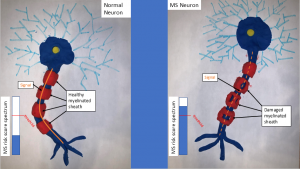A mixed-media depiction of how multiple sclerosis affects nerve cells and the signaling pathway. This disease can have several predispositions so I have depicted the summation of risk factors in terms of a spectrum with a threshold at “having MS (above threshold)” or “not having MS(below threshold)”. In general, risk factors vary from genetics, the environment, and even sex.


This STEAM project is on multiple sclerosis. The observation piece included two examples of a clay model with different colors representing the different aspects of a neuron that were revealing the aftermath of MS exacerbation. The main colors were red which represented the myelin sheath, blue which represented the nerve cell, and yellow represented the nucleus. The comparison revealed that dried out clay was like the myelin sheath in a neuron, rigid and more than likely unrepairable.
The essay portion of this essay reveals how MS can go unnoticed until a flare up occurs, which the reason is unknown why a flare up happens. Having MS greatly affects your health, and can cause permanent damage as MS is an autoimmune disease that affects the central nervous system (CNS). Reed compared that once a flare up happens, it can be like a fuse box in a house as in cascading pathways originated from the fuse are affected (excellent comparison in my opinion). This essay explained how Reed said he thought of having the disease as being on a spectrum, with a threshold of “having MS” or “not having MS” because the causes of the disease are very broad. Risk factors that contribute to the probability of having MS include sex, presence of certain genes, and environmental factors. Certain genes were explained at causing a person to have a higher risk of having MS, such as HLA-DRB1, IL2RA, CLEC16, and CD226. Immunosuppressants are usually taken by those who try to manage MS which help weaken the immune system. Chemotherapy and STEM cell are ways being used to reset the immune system by researchers as well.